Software and hardware for a 4D printer with applications in the biomedical industry have been developed by researchers at Universidad Carlos III de Madrid (UC3M). This machine also enables the control of additional functions, such as programming the material’s response to change shape in response to an external magnetic field or its electric properties to change in response to mechanical deformation.
This makes it possible to create soft robotics, intelligent sensors, and substrates that send signals to various cellular systems, among other things.
This research area focuses on the creation of soft multifunctional structures made of materials whose mechanical characteristics closely resemble those of biological tissues like the skin and the brain. Moreover, they can change their appearance or characteristics in response to outside stimuli like magnetic fields or electric currents.
But, they were quite constrained in terms of shape design and programming of intelligent reactions. Up until recently, this research team had produced a number of improvements in the design and manufacture of these structures.
The work presented in their latest study, published in the journal Advanced Materials Technologies, has allowed them to open up new possibilities by developing a novel 4D printing methodology.
“This technology allows us to not only control the way we print three-dimensional structures, but also to give them the ability to change their properties or geometry in response to the action of external magnetic fields, or the ability to modify their electric properties when they deform,” explains one of the researchers, Daniel García González, head of the ERC 4D-BIOMAP (GA 947723) project and associate professor in UC3M’s Department of Continuum Mechanics and Structure Theory.
Since the substance to be extruded changes from a liquid to a solid throughout the printing process, this sort of printing is complicated. So, it is essential to comprehend material dynamics in order to modify the manufacturing process and produce a material that is enough liquid to pass through the printer nozzle yet solid enough to hold a particular shape.
We can think of sensors that, attached to our body, collect information about our movement from variations in electric conductivity. In addition, the material’s self-healing capability allows the design of sensors with binary signals. For example, if we have had a knee injury and need to limit rotation to a maximum value, we can incorporate a small band of this material over our joint. This way, when we exceed this maximum rotation, the material will break showing an abrupt change in its electric properties, thus providing a warning signal. However, when returning the knee to a relaxed state, the material’s healing capability will result in recovery of the electric signal. This way we can monitor our movements and warn of risky conditions after surgery or during rehabilitation periods.
Daniel Garcia González
To this end, they have developed an interdisciplinary methodology that combines theoretical and experimental techniques allowing them to build the printing device from scratch, both the physical part of the device (the hardware) and the computer programmes that allow it to be controlled (the software).
A self-healing material
The researchers have also developed a new material concept that is capable of healing itself autonomously without the need for external action, according to another recent publication in the journal Composites Part B: Engineering.
“This material consists of a soft polymer matrix embedded with magnetic particles with a remanent field. For practical purposes, it is as if we had small magnets distributed in the material, so that, if it breaks, when the resulting parts are brought together again, they will physically join recovering their structural integrity,” says Daniel García González.
They have been able to print three different types of functional materials as a result of these developments, which have generated several registered patents: some of them change their shape and properties in response to external magnetic fields; others have the ability to heal themselves; and still others have electrical properties (conductivity) that change depending on their shape or deformation.
They have created intelligent substrates using the first kind of material to send forces and signals to cellular systems and impact biological processes including cell migration and proliferation. Soft robots that can be controlled by magnetic fields can also be created using these materials.
The development of sensors is greatly expanded by the combination of self-healing materials and materials whose electric conduction properties change with deformation.
“We can think of sensors that, attached to our body, collect information about our movement from variations in electric conductivity. In addition, the material’s self-healing capability allows the design of sensors with binary signals. For example, if we have had a knee injury and need to limit rotation to a maximum value, we can incorporate a small band of this material over our joint. This way, when we exceed this maximum rotation, the material will break showing an abrupt change in its electric properties, thus providing a warning signal. However, when returning the knee to a relaxed state, the material’s healing capability will result in recovery of the electric signal. This way we can monitor our movements and warn of risky conditions after surgery or during rehabilitation periods,” says Daniel Garcia González.





